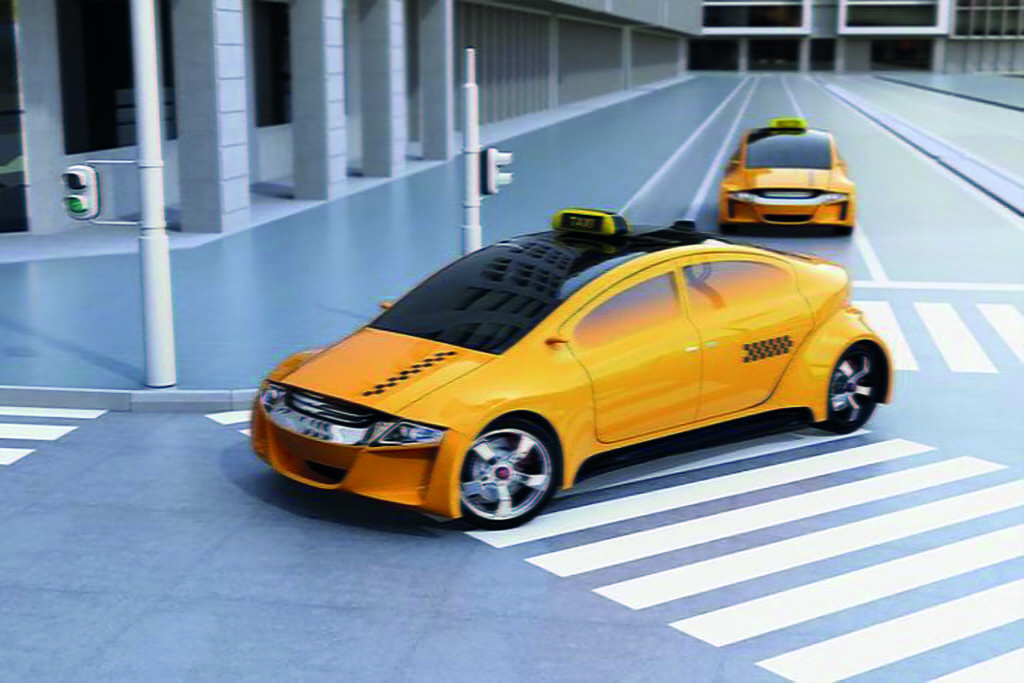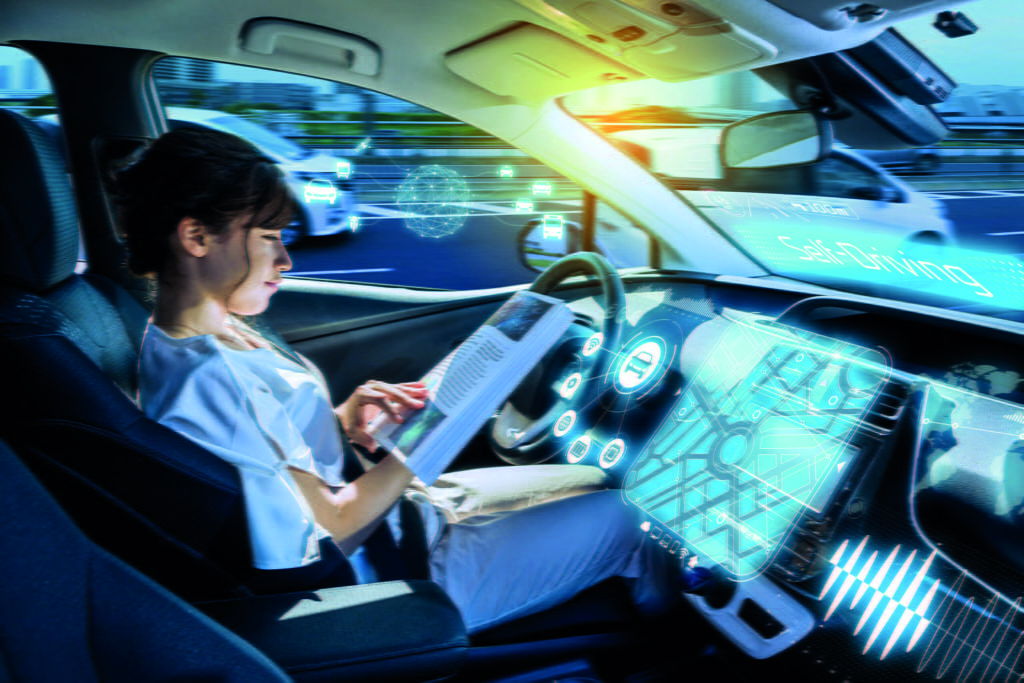Your attention, please
Ten things about automated vehicles that urban transportation planners need to know, evinced by Bern Grush
"Vehicle automation will change the modal arsenal for both private choice and public governance"
Professional planners in many cities are starting to think about what automated vehicles will mean to their land use, traffic management, and transit planning. Hype is rampant with the spectre of “full automation” arriving shortly — which is not exactly right since what will arrive will be constrained to specific areas, times, distances, weather and speeds for some time yet. But it is coming. So, what should urban planners be aware of and how can they prepare, given the extraordinary uncertainty about the nature and the timing of this technology?
1.TWO MARKETS
For most of the past several years we have been barraged with several stages or flavours of automation — partial automation, self-driving, driverless, fully automated. We have been shown images of drivers reading and working in the driver’s seat. We are told we will soon be able to sleep there. We read stories about robotaxis without drivers — that they’re coming to your city soon. This hype should not distract planners. What does matter is whether the majority of the public continues to buy and sell cars, which we call Market 1, or shifts to buying and selling rides, which we call Market 2.
If one group of planners were tasked to plan a city such that 95 per cent of all residents used a personal vehicle (like now, but with fewer fatalities) and a second group of planners were tasked with planning the same city such that 95 per cent would rely entirely on on-demand robotaxis, these two sets of planners would create entirely different cities. Why this matters is that many planners prefer the forecasts of a very high use of robotaxis (Market 2) and a dramatic reduction in car ownership (Market 1) over the next two or three decades. While we can expect some combination of these two markets, the key questions become: how much will the scale tip toward Market 2 and how much should it be tilted by the hand of government?
2. CONTRADICTORY EFFICIENCIES
Travellers have modal and travel-time preferences for personal reasons: time, cost, comfort, prestige, hygiene, loads, convenience, privacy, kids, trip chaining, pets, age and distance. Market 1 (car-buying) addresses this. Market 1 predominates today in most developed countries.
Urban and transit planners design land and transportation systems for urban design and sustainability reasons: spatial, environmental, traffic flow, tax, infrastructure, parking management, growth and liveability. Market 2 (ride-buying) is favoured by urban planners in the same countries.
These two efficiency models pull in opposite directions. Each is optimal for its context, but for incompatible reasons. Hence they conflict. Vehicle automation will change the modal arsenal for both private choice and public governance. I expect the competition between Markets 1 and 2 to continue as it has for the past 120 years. But will the social and structural rules of public policy change enough to alter its outcome?
3. AUTOMATION ENABLES (BUT DOES NOT REQUIRE) SHARING
While automation enables sharing, there is no guarantee that the current revealed preferences regarding Market 1 or Market 2 will be altered more than a little unless the fundamental traveller preference structure changes, whether spontaneously or through nudges. The ingrained behavioural manifestations are clearly supported by the current installed base that exploits present day technology, infrastructure and social norms.
Reduced trip costs will be insufficient as a primary motivator to make the change to 95 per cent robotaxis by 2030 that futurists Tony Seba and Jamie Arbib (ReThinkX) insist will transpire. If that were enough, singleoccupant car travel and congestion would not remain so stubbornly high even as new urban rail links open and ride-hailing soars in popularity.
"Innovation disrupts, removes costs and adds capabilities, data, opportunities and changes that are hard to anticipate — and even harder to prepare for"

4. AUTOMATION ANXIETIES
There are other barriers. Early Market 2 automated vehicles — taxis and shuttles — will be geofenced (constrained to specific areas and roads). They offer a perfect alternative to our current taxi, ride-hailing and bus systems within geographic boundaries.
Where they are widely deployed, Market 2 vehicles would soon become preferred, bringing about the demise of today’s local taxi, ridehailing and bus. However, because driverless cars cannot go everywhere in their early decades they will not be suitable as replacements for the family car. We call this access anxiety, which is more problematic for sales of personal vehicles than is the range anxiety associated with battery-electric cars.
Access anxiety will initially constrain driverless cars to the business of robotaxis that disrupt today’s ridehailing and public transit systems as those users are clearly accustomed to such access constraints. During the next couple of decades, access anxiety will help sustain automotive manufacturers that sell Market 2 cars and light trucks for personal and family use.
Today, people who are polled are anxious about not being in control or not trusting this impending technology. As a current reference to a much older technology, about 18 per cent of adult Americans are anxious about flying and an additional 13 per cent are afraid to fly altogether in spite of the safety record of today’s airlines (https://flyfright.com/statistics/).
Many people are concerned about privacy and security in the automated vehicles of the future. Others are anxious that a suitable car might not always be immediately available.
These anxieties will ease as they usually do with new technologies, but they are numerous and many will likely ease only slowly, due to setbacks after with each accident, each privacy breach, each security failure and each service hiccup.
5. EVIDENCE FAILS TO PROVE WE WILL ALL USE ROBOTAXIS
The argument that most of us will move away from Market 1 to become Market 2 ride buyers is, in reality, a hopeful assumption largely based on the human preference for lower cost and driver dislike for nuisances such as congestion or finding and paying for parking. The greater number of arguments for owning a personal vehicle — at whatever level of automation — includes the litany I listed above.
We may be confident that automated taxis and shuttles will disrupt our current formats of public conveyances and we may believe that urban, per-household vehicle ownership has reason to fall. However, projections of a majority — or even a significantly greater portion — of families becoming zero-car families in the near-future seems far-fetched — at least before fleet services are available to match or exceed today’s preference configuration for owning family vehicles. This will be a difficult deployment, regulatory and infrastructural task. A task that receives too little attention to achieve the outcome we seek.

6. INNOVATION FAVOURS CAR OWNERSHIP AND USE
Innovation disrupts, removes costs and adds capabilities, data, opportunities and changes that are hard to anticipate — and even harder to prepare for.
Given its potential range, unfettered innovation will do more to enhance the experience of the personal Market 1 vehicle than it will for the publicly shared Market 2 fleet vehicle. As costs are driven out, and access to small reliable electric vehicles improves, the desirability of a personal vehicle will remain as a significant rival to buying rides in public conveyances.
To have individuals and especially families rely entirely on on-demand vehicles requires a spectrum and level of service innovation that we have not yet imagined much less described. Any residual reasons to own personal vehicles guarantee that such owners would more often use those vehicles.
To overcome this factor the ride industry and its promoters need to innovate deployment, regulations, infrastructure, services and costs that make Market 2 more attractive than Market 1 to most travelers. We are far from that today. Planners may dream about a Market 2-dominant world, but there is not yet described a feasible plan to get there.
7. DIFFUSION OF AVS (SOUTH TO NORTH)
Waymo is promising to launch a revenue-generating robotaxi service in the sunny, snow-free Phoenix, Arizona metro area during winter 2018-19. When this happens, Market 2 driverless automation enters its infancy in modern cities. Until then, everything else is hype. If the technology sees user acceptance, it will spread as rapidly as the vehicles can be manufactured and operating areas within cities mapped and geofenced.
But they will be slowed by nasty weather. If you have 10 to 25 per cent of a city’s population relying on these vehicles, having a robotaxi fleet grounded due to snow will be unacceptable. Until this technology reaches a high level of reliability in poor weather conditions, northern cities, which are not yet planned, will see a delayed future. T
hese cities have an opportunity to watch and study deployments to the south, so that in spite of snow in more northern cities, perhaps they will learn how to achieve easier deployments.
8. THE TRAGEDY OF THE COMMONS WILL MOVE INSIDE THE VEHICLE
The public commons we know as our roads and streets is subject to the tragedy of the commons from our driving and parking behaviour. Most cities have too many vehicles in a limited geographical space, to the degree that city populations adopt vehicle automation with multiple passengers per vehicle, this commons will become less abused, less risky for cyclists and pedestrians, less of a random killing field, less polluted, quieter and more reliable.
To the degree Market 2 ride-buying is successful in making public roads safer and calmer, perhaps becoming dominant, so a new, expanding public commons will migrate to the inside of our vehicles.
I own a car. The inside is my personal space, a private extension of my living room and dining room. When I use the bus or subway I am in a public commons subject to its abuses. When I am in a Lyft vehicle, I know the driver owns the vehicle. I behave in between. But I worry less about the mud on my shoes.
How will we behave in vehicles we do not own and that have no driver to supervise our behaviour? How this new commons is managed will be critical to motivating Market 1 car owners to become Market 2 ride buyers. Many people would balk. People who use public transit will understand this problem — and perhaps be inured to it. But too few of us are thinking this through for the majority who are not.
9. ATTENTION IS THE PRIME MOTIVATOR
Everything attractive to consumers of automated vehicles involves attention or distraction. Safe travel in vehicles that do not require driver attention is a huge safety benefit. Right behind safety is the diversion of passenger attention to other things: read, work, play, sleep, call, watch, surf, drink. Be more productive. Be safe while distracted.
Remember when the gold standard for websites was eyeball counts? Passenger-vehicle automation is this history repeating.
The reason the people-transport market is slated to expand from a couple of trillion dollars to seven to 10 trillion dollars by 2050 is because automation allows the capture of more attention — and its implied knock-on value.
The Attention Economy implies that time freed up by automation will be monetized. If 50 per cent of 37.5 million Canadians spend an hour a day driving a car, that represents 6.7 billion new hours of attention capture opportunity.
Is it time to start thinking about the justification for road use fees (or taxes) to be paid by in-vehicle advertisers?
"Everything attractive to consumers of automated vehicles involves attention or distraction. Safe travel in vehicles that do not require driver attention is a huge safety benefit"

10. CONGESTION WILL BE MONETIZED
Passenger time sitting in vehicles is monetizable. If you are a driver today, then sitting as a passenger in a driverless vehicle tomorrow means you will most likely contribute to a new captive market for attention. That market grows with congestion.
There are only 24 hours in each human’s day — far fewer if you discount for biological requirements and work-related hours. The remaining hours — perhaps three to five are already subject to attention monetization (smartphone, computer ads, TV, radio, billboards). Removing the driving task considerably increases the fraction and capturability of monetizable time —perhaps, an additional hour each day for a typical adult or teen — so we’re talking a 20 to 33 per cent increase. Time inside a vehicle is captive. According to Sara Fischer of Axios, media and advertising companies will “create more opportunities for people to view media content and advertising.” As vehicles become increasingly automated and travellers drive less and less, industry will change how it thinks about marketing and serving content.
Imagine being served up a Netflix serial in tailored, trip-sized chunks instead of the way episodes are currently chopped for an hour’s viewing. Imagine a car routing or pacing itself to be sure you see the full segment with its embedded ads. Imagine if tripsized YouTube videos are picked for you based on your likes and dislikes, with tailored ads, of course, serving to put your attention on automaticcapture as a continuous extension throughout all your trips.
Even with interim conditional automation in personal vehicles, locationbased in-vehicle targeting coordinated with dynamic billboard advertising will innovate.
Will robotaxi operators be more focussed on moving you from A to B or more interested in monetizing every second of your trip? Congestion has long been valuable to any company who sells you things for automotive trips. The American economist Anthony Downs made this clear in his seminal book Still Stuck in Traffic (2004):
“… my advice to…drivers stuck in peak hour traffic is… Get accustomed to it! Get a comfortable, air-conditioned car with a stereo radio, a tape player, a CD player, a hands-free telephone, perhaps a fax machine and a microwave oven, and commute with someone you really like. Then regard the moments spent stuck in traffic simply as an addition to your leisure time.”
If the data enabling your attention capture during a robotaxi trip are monetizable, trip length will accrue value to shareholders. Think about that in case you thought robotaxi companies are coming to traffic’s rescue and take congestion away.
Politicians are still afraid of road pricing, but governments will need to get over that fear in order to offset the fact the congestion will soon represent massive shareholder value.
"Imagine being served up a Netflix serial in tailored, trip-sized chunks instead of the way episodes are currently chopped for an hour’s viewing. Imagine a car routing or pacing itself to be sure you see the full segment with its embedded ads"

THE CHALLENGE
Until now most cities have been waiting for the fog of uncertainty to dissipate. Some are enumerating things that will need to be addressed and considering aspirational goals, for example what to wish for 2050 or for when all vehicles are fully automated.
As the real driverless robotaxi ends its gestation period in the months ahead, here is my recommendation:
Forget about 2050 for now. Consider instead what you need to do to have your city move 10 per cent of its passenger kilometres travel in robotaxis by 2028. Who will those passengers be? Where will they get picked up or dropped off? What will be encouraged? Discouraged? How big will this fleet be? What size vehicles will you permit? What changes will you make to the curb? And where? Will the fleet be privately or publicly owned? Or both? Do you care? How will it be policed? How will this affect your buses or trains? What hand will you take in influencing their social-equity impact? How will seniors be served? Or will they be? How should TNCs be managed in the interim, since they are the natural segue to robotic fleets?
The list to consider is indeed far longer than space allows. I encourage you to become a Ten Per Cent City now on your way to becoming a “smart city” later. Getting the first 10 per cent right is key to the next 50 per cent happening at all.
FYI
Bern Grush has most recently co-founded Harmonize Mobility to address the governance of massive competing fleets of robotaxis.
bern@harmonizemobility.com
This article is excerpted from a new book coming in 2019: The End of Driving: The Ten Percent City by Bern Grush and John Niles. It is the follow-up from the authors’ successful: The End of Driving: Transportation Systems and Public Policy Planning for Autonomous Vehicles (Elsevier, 2018).
 Self drive car, autopilot, driverless car
Self drive car, autopilot, driverless car